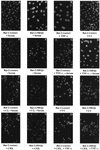Transforming potential of the herpesvirus oncoprotein MEQ: morphological transformation, serum-independent growth, and inhibition of apoptosis
- PMID: 9420237
- PMCID: PMC109386
- DOI: 10.1128/JVI.72.1.388-395.1998
Transforming potential of the herpesvirus oncoprotein MEQ: morphological transformation, serum-independent growth, and inhibition of apoptosis
Abstract
Marek's disease virus (MDV) induces the rapid development of overwhelming T-cell lymphomas in chickens. One of its candidate oncogenes, meq (MDV Eco Q) which encodes a bZIP protein, has been biochemically characterized as a transcription factor. Interestingly, MEQ proteins are expressed not only in the nucleoplasm but also in the coiled bodies and the nucleolus. Its novel subcellular localization suggests that MEQ may be involved in other functions beyond its transcriptional potential. In this report we show that MEQ proteins are expressed ubiquitously and abundantly in MDV tumor cell lines. Overexpression of MEQ results in transformation of a rodent fibroblast cell line, Rat-2. The criteria of transformation are based on morphological transfiguration, anchorage-independent growth, and serum-independent growth. Furthermore, MEQ is able to distend the transforming capacity of MEQ-transformed Rat-2 cells through inhibition of apoptosis. Specifically, MEQ can efficiently protect Rat-2 cells from cell death induced by multiple modes including tumor necrosis factor alpha, C2-ceramide, UV irradiation, and serum deprivation. Its antiapoptotic function requires new protein synthesis, as treatment with a protein synthesis inhibitor, cycloheximide, partially reversed MEQ's antiapoptotic effect. Coincidentally, transcriptional induction of bcl-2 and suppression of bax are also observed in MEQ-transformed Rat-2 cells. Taken together, our results suggest that MEQ antagonizes apoptosis through regulation of its downstream target genes involved in apoptotic and/or antiapoptotic pathways.
Figures







Similar articles
-
Marek's disease virus-encoded Meq gene is involved in transformation of lymphocytes but is dispensable for replication.Proc Natl Acad Sci U S A. 2004 Aug 10;101(32):11815-20. doi: 10.1073/pnas.0404508101. Epub 2004 Aug 2. Proc Natl Acad Sci U S A. 2004. PMID: 15289599 Free PMC article.
-
Marek's disease herpesvirus transforming protein MEQ: a c-Jun analogue with an alternative life style.Virus Genes. 2000;21(1-2):51-64. Virus Genes. 2000. PMID: 11022789 Review.
-
Marek's disease virus latent protein MEQ: delineation of an epitope in the BR1 domain involved in nuclear localization.Virus Genes. 2003 Dec;27(3):211-8. doi: 10.1023/a:1026334130092. Virus Genes. 2003. PMID: 14618081
-
Expression of Marek's Disease Virus Oncoprotein Meq During Infection in the Natural Host.Virology. 2017 Mar;503:103-113. doi: 10.1016/j.virol.2017.01.011. Epub 2017 Feb 1. Virology. 2017. PMID: 28160668
-
T-cell transformation by Marek's disease virus.Trends Microbiol. 1999 Jan;7(1):22-9. doi: 10.1016/s0966-842x(98)01427-9. Trends Microbiol. 1999. PMID: 10068994 Review.
Cited by
-
Marek's disease viral interleukin-8 promotes lymphoma formation through targeted recruitment of B cells and CD4+ CD25+ T cells.J Virol. 2012 Aug;86(16):8536-45. doi: 10.1128/JVI.00556-12. Epub 2012 May 30. J Virol. 2012. PMID: 22647701 Free PMC article.
-
Marek's disease virus-encoded Meq gene is involved in transformation of lymphocytes but is dispensable for replication.Proc Natl Acad Sci U S A. 2004 Aug 10;101(32):11815-20. doi: 10.1073/pnas.0404508101. Epub 2004 Aug 2. Proc Natl Acad Sci U S A. 2004. PMID: 15289599 Free PMC article.
-
Analysis of transcriptional activities of the Meq proteins present in highly virulent Marek's disease virus strains, RB1B and Md5.Virus Genes. 2011 Aug;43(1):66-71. doi: 10.1007/s11262-011-0612-x. Epub 2011 Apr 19. Virus Genes. 2011. PMID: 21503681
-
Marek's disease virus Meq oncoprotein interacts with chicken HDAC 1 and 2 and mediates their degradation via proteasome dependent pathway.Sci Rep. 2021 Jan 12;11(1):637. doi: 10.1038/s41598-020-80792-2. Sci Rep. 2021. PMID: 33437016 Free PMC article.
-
Amino acid insertion in the Meq protein of Marek's disease virus, an avian oncogenic herpesvirus, accelerates tumorigenesis.Microbiol Spectr. 2025 Aug 5;13(8):e0336824. doi: 10.1128/spectrum.03368-24. Epub 2025 Jul 17. Microbiol Spectr. 2025. PMID: 40673706 Free PMC article.
References
-
- Akiyama Y, Kato S. Two cell lines from lymphomas of Marek’s disease. Biken J. 1974;17:105–116. - PubMed
-
- Angel P, Karin M. The role of Jun, Fos and the AP-1 complex in cell proliferation and transformation. Biochim Biophys Acta. 1991;1072:129–157. - PubMed
-
- Bertin J, Armstrong R C, Ottilie S, Martin D A, Wang Y, Banks S, Wang G-H, Senkenvich T G, Alnemri E S, Moss B, Lenardo M J, Tomaselli K J, Cohen J I. Death effector domain-containing herpesvirus and poxvirus proteins inhibit both Fas- and TNFR-induced apoptosis. Proc Natl Acad Sci USA. 1997;94:1172–1176. - PMC - PubMed
-
- Bishop J M. Molecular themes in oncogenesis. Cell. 1991;64:235–248. - PubMed
-
- Brunovskis, P. 1997. Personal communication.
Publication types
MeSH terms
Substances
Grants and funding
LinkOut - more resources
Full Text Sources
Research Materials
Miscellaneous

